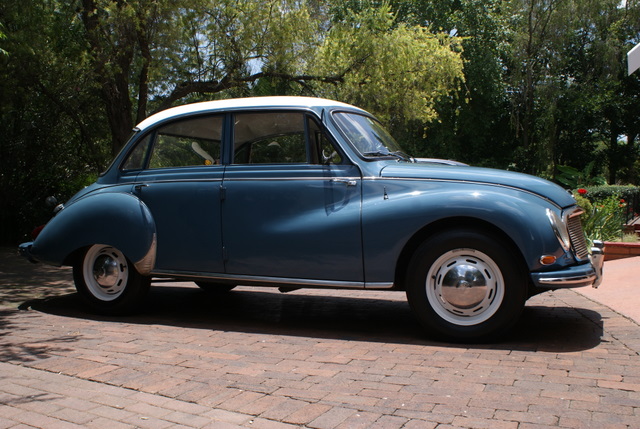
Big Al's Poker Run was held on Saturday 12th February 2012 and was bigger and better than ever. I think there were a few less hot-rods and 1950s American cars and a much bigger contingent of Australian classics this year. There were also some classic cars on display.



This magnificent 1930s Chevrolet car had a career as an endurance racer.

The boat tailed bodywork was constructed from canvas stretched over a wood frame. This made the car both streamlined and light. The two cockpit-like seats in the rear were actually built to hold double fuel tanks for endurance racing. In the days before safety regulations the on-board mechanic's would refuel their cars and check and top up the oil while the cars were in motion, moving back and forth along the running boards.

Shelly chatting with the owner.

Rusty the co-pilot takes a rest

1927 Pontiac Sports Roadster. Apparently one of only three in the world.


1927 Chrysler Model 75


1938 Dodge

A lovely 1940 Ford Deluxe.

Not all cars, there was a few odd balls like this 1940s tow truck.

A stunningly restored Edsel. http://www.edsel.com/

The Edsel can't escape its reputation as "one of the worst car's of all time" but that's scarcely fair. The Edsel was a relatively good car for its era with lots of excellent and unusual features. But it was ill-timed, coming on the market just as the American economy went into a downturn. And of course its marketing was ultimately to blame, trumpeting the Edsel as something more than it really was - which was after all just a car. The Edsel was in production for 3 years.

Push button gear shifters appeared in several American cars in the 1940s and 50s but only the Edsel put push button gears on the steering hub.

1955 Cadillac. A gorgeous car

Something new this year - a stall selling toy cars and other collectables.

The Ford Customline was a popular car at the show. I think we saw about four there.

Ford Customline


1961 EK Holden - lovely cars

Part of the American contingent




1959 Chevrolet Impala. I always wanted one of these beautiful cars. You gotta love the wings!



Thunderbirds are go!



A bit of an oddity among the American cars - a hotted up Triumph wagon

A Lincoln Continental

Those amazing outward opening doors are just made for a big entrance. This is the kind of car you'd expect John F Kennedy to have ridden in.

Ford Mustang


Ford Fairlane

A HR Holden (right) and EH Holden (left)

Holden Monaro. These now obtain ridiculous prices.

1970s Aussie muscle - Fords versus Holden

Chevrolet Camaro

Pontiac Firebird

Ford Falcon interceptor. Some might find it odd, given my taste in arcane vehicles, but I almost bought one of these when I was seventeen years old. It was this very model with the green and white paint scheme and was $6000. Not a lot today of course but at that time my annual wage. Then my grandfather died and inherited his 1963 EH Holden which I drove and loved for almost ten years.

Mad Max's Ford Interceptor. What a car! What a fantastic opening chase scene. As a teenage boy I loved that film and watched it over and over on video. It was this car that made me want to buy the Falcon pictured above. http://en.wikipedia.org/wiki/Mad_Max#Plot_summary


The sleek lines of the Chevrolet Corvette


Here's a really interesting car. 1948 Debonde Sports V8. Although you wouldn't recognise it now this was originally a 1939 Ford V8 sedan that was stripped down for racing. In 1948 Fred Debonde and Ron Possett stripped the ford down to its chassis and installed this new, sleek bodywork. A 4800cc Ford Mercury V8 engine was slipped under the hood and the car went on to a successful racing career in the late 1940s and early 1950s.


A wee rippa! Honda S600. http://www.hondas600.com/ With these little cars the Japanese were able to undercut the market for light sports cars that was dominated by British brands like MG and Triumph.


The run gets underway


The Edsel hits the road. I don't care what anyone says - this car makes a statement.

A jet boat roars past on the river side.
For anyone who missed the show or can't get enough there is the Max Murray Auto Xtravaganza on Easter Saturday 7th April 2012 at the Sir Ross McLarty Oval, Pinjarra. Details can be found online http://www.maxpinjarra.com.au/
For photos of previous years shows -
http://www.heinkelscooter.blogspot.com.au/2010/02/big-al.html
http://www.heinkelscooter.blogspot.com.au/2011/02/big-als-poker-run-2011.html





































